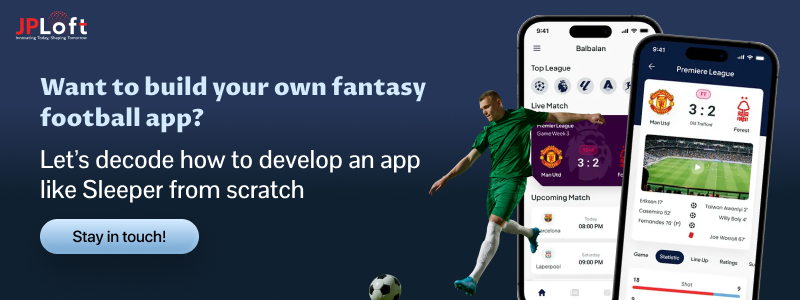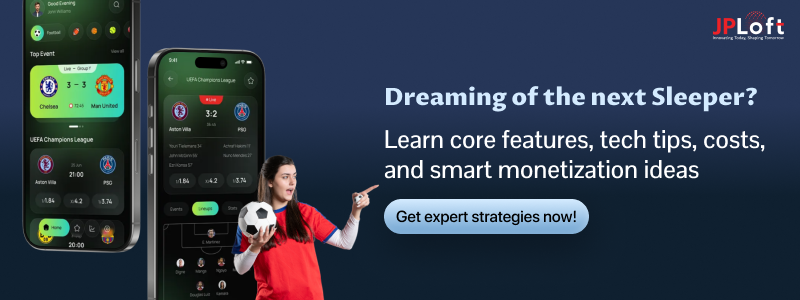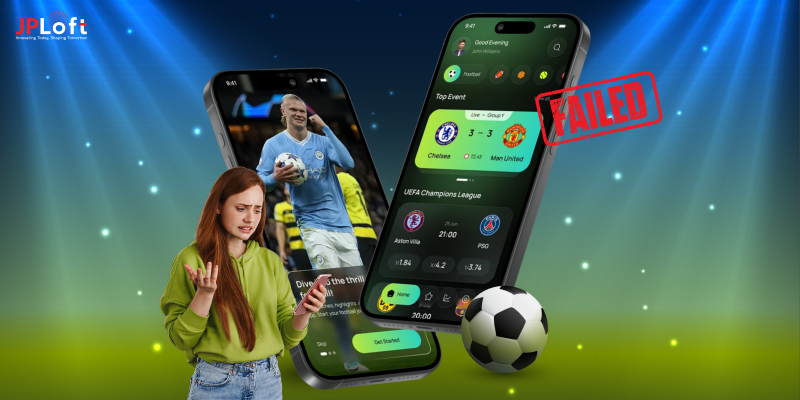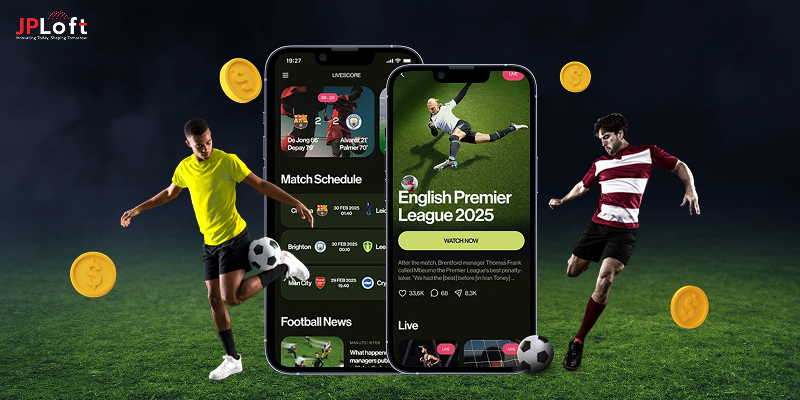In a world where digital gaming is booming, many entrepreneurs are now aiming to develop a fantasy football app that captures the same hype and user love as Sleeper. With the fantasy sports market projected to cross $78.5 billion by 2030, the opportunity is massive.
Users today are looking for smarter, faster, and more interactive gaming experiences. Apps like Sleeper have set the benchmark with sleek design, real-time features, and community-driven play.
This blog is your complete guide to develop a fantasy football app like Sleeper, covering everything from must-have features to cost breakdown, tech stack, and monetization strategies. Let’s dive into the depths of the development journey.
What is a Sleeper App?
Sleeper is one of the most popular fantasy football apps out there and for good reason. It’s a modern, user-friendly platform that lets sports fans create fantasy leagues, draft players, make trades, and track scores in real time.
But what really makes Sleeper stand out is its social-first approach. It’s not just about stats, it’s about chatting with friends, sharing reactions, and feeling like part of a community.
Unlike many traditional fantasy sports platforms, Sleeper keeps things fun, interactive, and mobile-optimized. From push notifications to live player updates and built-in group chats, it gives users the thrill of the game without complexity.
If you’re planning to develop a fantasy football app, understanding you should invest in it is the perfect starting point. Let’s understand it.
Why Should You Invest to Develop an App like Sleeper?
If you're wondering why now is the right time to develop a fantasy football app, here are some strong reasons to back your decision:
-
Booming Market Growth: The fantasy sports industry is growing rapidly and is expected to cross $78.5 billion by 2030. That’s a huge opportunity for anyone planning to make a fantasy football app like Sleeper.
-
High User Engagement: Apps like Sleeper are more than just games, they’re communities. Users spend hours managing teams, chatting with friends, and checking scores. High engagement means better retention and more monetization chances.
-
Profitable Monetization Models: Whether it’s in-app purchases, premium features, or ad revenue, you can explore multiple income streams when you build a fantasy football app like Sleeper.
-
Tech is Accessible: With the right guide on how to develop a fantasy football app like Sleeper, even startups or solo founders can enter the market without a huge tech team.
-
Loyal Fan Base: Sports fans are loyal and if your app delivers a great experience, they’ll stick around and bring friends too.
So, if you’ve ever dreamed of creating something exciting, engaging, and profitable, this is your chance. With the right strategy, you can make a fantasy football app like Sleeper and turn your vision into a winning reality.
Core Features of a Fantasy Football App Like Sleeper
Thinking about how to develop an app like Sleeper? Then you’ll need to know what makes it amazing. It’s the features that make the app more user-friendly.
From live drafts to real-time scores, these powerful features of fantasy football apps are the backbone of any successful fantasy football app. Here's what your app absolutely must have:
1. User Registration & Profiles
Every great app journey starts with a smooth onboarding experience. Your app should allow users to register quickly via email or social logins like Google or Facebook. Once registered, users should be able to create and customize their profiles with avatars, usernames, and team details, just like they do on Sleeper.
2. League Creation & Management
The heart of fantasy football lies in the leagues. Users should be able to create both public and private leagues, invite friends, and define league rules. This feature should be flexible enough to cater to casual users and hardcore fantasy enthusiasts alike.
3. Live Draft System
One of the most exciting parts of the fantasy football experience is the live draft. Your app should support real-time drafting, including timers, auto-pick options, and even mock drafts to help users practice. This brings the excitement of real-world team selection right into the app.
4. Team Management
A user’s fantasy team is their pride, and managing it should be both intuitive and enjoyable. Your app should allow users to set lineups, manage player rosters, propose and accept trades, and adjust strategies week by week.
5. Real-Time Scoring & Updates
Real-time stats and live score updates keep the adrenaline pumping. Users should receive instant updates on player performances, match scores, and overall league rankings. This live data is what turns a passive app experience into an immersive one.
6. In-App Chat & Community Features
One of Sleeper’s standout features is its vibrant community and chat system. Integrate a chat function where league members can talk, drop GIFs, conduct polls, or even trash talk playfully. This social layer adds a fun and personal element to the gaming experience.
7. Push Notifications
Timely notifications are essential to keep users engaged. Alerts for player injuries, upcoming drafts, trade proposals, and weekly matchup results can drive user re-engagement and ensure no one misses a moment.
8. Admin Panel
On the backend, you’ll need a robust admin panel to manage user data, monitor leagues, oversee scoring algorithms, and control in-app functionalities. It’s the control center that ensures everything runs smoothly behind the scenes.
9. Monetization Options
If you're planning to generate revenue, include multiple monetization methods. These could be in-app purchases, premium subscription plans, ad placements, or even exclusive features available only to paying users.
10. Cross-Platform Compatibility
To maximize reach, your app should be accessible across both iOS and Android devices. A seamless, consistent experience across platforms ensures no user feels left out, regardless of their device.
If you want to build a fantasy football app like Sleeper, then these features aren’t optional, they’re essential for user retention, engagement, and long-term growth.
Step-by-Step Process to Develop an App like Sleeper
When you are thinking about app development, the first question comes to mind is “how to develop an app like Sleeper?” But you're not alone with this question.
Many entrepreneurs, startups, and sports tech businesses are facing the question entering the fantasy sports world with the ambition to create a fantasy football app like Sleeper.
Sleeper’s slick design, real-time capabilities, and community-focused features have set a benchmark in the industry. Let’s break down the step-by-step process to develop an app like Sleeper, from idea to launch and beyond.
Step 1: Conduct Market Research and Define Your Niche
The first step is research. To succeed in this space, you need to deeply understand what users love about apps like Sleeper and where current solutions fall short. Study your competitors, explore the latest fantasy football app trends, and identify what audience you want to target.
Whether you're building for sports fans, casual players, or a specific region, your niche will guide your app’s direction. Knowing your audience also helps you define a unique proposition.
This clarity will shape your development strategy and ensure that when you make an app like Sleeper, it offers something fresh and valuable.
Step 2: Define Features and Functional Scope
Once you have a clear idea of your market, you need to decide on the core features your app will offer. A successful fantasy football app needs much more than just a leaderboard and team dashboard.
It should include user profiles, league creation tools, a smooth drafting experience, real-time scoring, trade management, push notifications, and chat functionality. If you're trying to build a fantasy football app like Sleeper, user engagement is everything.
A social layer with chat, emojis, and interactive elements can set your app apart.
Step 3: Choose the Right Development Partner
When it comes to turning your idea into a functioning product, choosing the right development partner is critical. You can collaborate with a specialized mobile app development company in Denver or any trusted location.
Working with an experienced company gives you access to expert guidance on choosing the right tech stack (like React Native, Flutter, Firebase, or Node.js), building app architecture, and ensuring your app is built with future scalability and performance in mind.
Step 4: Focus on UI/UX Design
A fantasy sports app isn’t just about functionality, it’s about how users feel when using it. To develop a fantasy football app like Sleeper, you must deliver a clean, intuitive, and visually appealing interface.
Think of it this way: your users should effortlessly browse stats, tweak their team, chat with friends, and get real-time updates, all without scratching their heads. So, start with app wireframing to plan out your app’s structure and user journeys.
Then move on to app prototyping to visualize and test the user flow before diving into full-scale development. This not only saves time but ensures your UI/UX is truly user-friendly.
Step 5: Test, Refine, and Optimize
Before launching your app publicly, app testing is a must. A fully functional fantasy football app should be free from bugs, performance lags, or user flow confusion. This includes both manual and automated testing of all features, from user login and draft functions to real-time score syncing and push notifications.
You should also run beta tests with a select group of users to gather feedback. If you’re committed to Sleeper clone app development, you need to ensure your version delivers an equally smooth or even better experience.
Step 6: Build a Go-To-Market Strategy
A solid Go-To-Market (GTM) strategy is crucial before launch. Identify your early adopters and focus your outreach on the platforms and communities they engage with.
Craft a clear messaging plan, onboarding flow, and user acquisition funnel. Use teaser videos, how-to guides, and influencer tie-ups to generate buzz.
A strong GTM approach helps overcome this, ensuring early traction and long-term user engagement.
Step 7: Launch and Promote
Now that your app is polished and ready, it’s time to go live. But launching isn’t just about making your app available, it’s about getting people genuinely excited. Start by submitting your iOS app to the App Store following Apple’s guidelines, ensuring you meet all design and performance standards.
Next, publish your app to Google Play Store, optimizing your listing with relevant keywords, engaging visuals, and compelling descriptions to improve discoverability.
Once both versions are live, create a buzz around your launch. Tap into fantasy football forums, Reddit communities, social media influencers, and targeted email campaigns to get your app in front of the right eyes.
Step 8: Post-Launch Maintenance and Feature Updates
Your journey doesn't end at launch, it’s only the beginning. To keep users engaged, you’ll need to monitor analytics, roll out updates, fix bugs quickly, app maintenance service, and add new features regularly.
Consider expanding your app to include other sports leagues like cricket, NBA, or even esports.
When you create a fantasy football app like Sleeper, post-launch care determines whether users stay loyal or drop off. Continue to innovate and keep the app fresh and exciting.
This step-by-step process to build an app like Sleeper offers everything you need to begin your journey. And if you're ready to turn your idea into a reality, now’s the time to partner with the best mobile app development company that understands the fantasy sports ecosystem inside-out.
Tech Stack for Creating a Fantasy Football App like Sleeper
Behind every seamless fantasy sports experience is a powerful tech stack. To build a fantasy football app like Sleeper, you need the right combination of frontend, backend, real-time data support, and third-party integrations.
Your technology choices directly impact app performance, scalability, and overall user experience.
Here’s a breakdown of the ideal fantasy football app tech stack:
|
Component |
Recommended Technologies |
Purpose |
|
Frontend Development |
React Native / Flutter |
Cross-platform development for smooth iOS & Android experiences |
|
Backend Development |
Node.js / Django / Ruby on Rails |
Handles server logic, APIs, and user management |
|
Database |
PostgreSQL / MongoDB |
Stores user data, match stats, game history |
|
Real-Time Updates |
Socket.IO / Firebase Realtime DB |
Delivers live scores, drafts, and chats instantly |
|
Push Notifications |
OneSignal / Firebase Cloud Messaging |
Notifies users about matches, team updates, and chat replies |
|
Authentication |
Firebase Auth / OAuth / Auth0 |
Ensures secure logins and account protection |
|
Payment Gateway |
Stripe / Razorpay / PayPal |
Enables in-app purchases, entry fees, and rewards handling |
|
Cloud Hosting |
AWS / Google Cloud / Heroku |
Scales infrastructure with traffic demands |
|
Analytics & Monitoring |
Google Analytics / Mixpanel / Sentry |
Tracks user behavior and app performance |
|
App Prototyping & Wireframing |
Figma / Adobe XD |
Designs and tests UI/UX flows before development begins |
Choosing the right tech stack for fantasy football apps is not just about features, it’s about building a foundation that supports real-time interactions, rich visuals, secure transactions, and scalable growth.
A powerful backend ensures seamless performance during peak match hours, while the right front-end framework enhances user engagement. Always choose technologies that align with your app’s complexity and future scalability goals.
Cost to Develop an App like Sleeper
The cost to develop an app like Sleeper typically ranges between $15,000 to $60,000+, depending on complexity, features, and tech integrations.
If you're planning to create an app with advanced functionalities like AI-driven player suggestions, predictive analytics, or smart draft assistants, the cost can increase significantly. AI requires powerful data handling, model training, and real-time processing, all of which influence development time and budget.
Additionally, app design, real-time scoring, scalability, cross-platform compatibility, and third-party API integrations also affect the overall pricing.
Here’s a quick breakdown of the cost to create a fantasy football app, based on the feature set:
|
Development Stage |
Estimated Cost |
Short Description |
|
UI/UX Design |
$2,000 – $5,000 |
Wireframing, user journey mapping, and creating intuitive, user-friendly interfaces. |
|
Frontend Development |
$3,000 – $10,000 |
Building the app screens, user interactions, and visual elements across platforms. |
|
Backend Development |
$5,000 – $15,000 |
Server-side logic, database, APIs, and third-party integrations like stats feeds. |
|
AI Integration (Optional) |
$5,000 – $12,000+ |
Adding machine learning for player insights, predictive features, or chatbots. |
|
Real-Time Features |
$4,000 – $8,000 |
Enabling live scoring, live drafts, chat, and instant push notifications. |
|
Testing & QA |
$1,500 – $4,000 |
Manual and automated testing to ensure smooth performance and bug-free experience. |
|
Deployment & Maintenance |
$2,000 – $6,000+ |
Launching on app stores, monitoring performance, and updating for new seasons. |
By understanding each development stage, you can better plan your budget and prioritize the most essential features. Building a basic version or going all-in with AI, every dollar spent should contribute to strong user engagement and long-term growth.
Mistakes to Avoid While Developing an App like Sleeper
Building a fantasy football app like Sleeper can be incredibly rewarding, but only if you avoid these common pitfalls. Here are the top mistakes that can derail your progress:
-
Ignoring Market Research: Skipping user research leads to low engagement. Understanding what fantasy sports fans actually want is key to overcoming early fantasy football app development challenges.
-
Choosing the Wrong Tech Stack: A poor tech foundation can result in slow performance and high maintenance costs. Choose scalable, modern technologies to avoid long-term headaches and escalating the cost to create a fantasy football app.
-
Overcomplicating the UI/UX: An app that's difficult to navigate will drive users away. Keep the user experience smooth and intuitive, just like top-tier apps such as Sleeper.
-
Underestimating Backend Scalability: Real-time stats, league updates, and user interactions require a robust backend. Failing to plan for scale is one of the most costly mistakes while developing a fantasy football app.
-
Skipping MVP Development: Trying to launch with too many features can lead to delays and overspending. Focus on a core feature set first, then scale gradually.
-
Ignoring AI & Personalization: In today’s competitive landscape, AI-driven features like personalized recommendations or smart team suggestions are becoming essential. Not investing in these can make your app feel outdated and increase the eventual cost of the app when added later.
-
Weak Go-To-Market Strategy: Even the best apps fail without visibility. A poorly planned launch can waste time, money, and momentum. Align your GTM with user behavior and digital trends for maximum impact.
Avoiding these mistakes not only reduces unnecessary costs but also speeds up your go-to-market timeline. Remember, a successful fantasy football app lies in smart planning, user-first design, and future-ready technology.
Build smart from the start and your app could be the next big thing in the fantasy sports world.
Future Trends to Develop an App like Sleeper
To make an app like Sleeper that truly stands out, it's important to embrace upcoming trends and innovations from day one.
With user expectations rising and technology evolving, embracing future trends will help you build an app like Sleeper that stands out in the competitive market.
A] AI-Driven Personalization
Integrating AI can transform the user experience by offering custom player suggestions, predictive analytics, and smarter draft recommendations. This trend is a must-have when you create a fantasy football app like Sleeper.
B] Blockchain for Transparency
To ensure fair play and secure transactions, many are incorporating blockchain. It boosts trust in gameplay and rewards, perfect if you want to create an app that users can truly rely on.
C] AR & VR Integration
Augmented and virtual reality are turning drafts and matches into immersive experiences. Sleeper-like app development can benefit from these technologies by offering interactive live events or virtual draft rooms.
D] Social & Community Features
Apps that mimic real-life banter and bonding win user loyalty. Forums, live chats, memes, and user-generated content are becoming key components to build an app like Sleeper.
E] Gamification and Reward Systems
Future-ready apps will not just be about playing, they’ll be about winning perks. Loyalty points, badges, and real-world rewards add long-term engagement value.
F] AI-Driven Personalization
Using AI app development services, you can add smart features like player suggestions, predictive analytics, and draft recommendations, essential if you want to create a fantasy football app like Sleeper with a personalized user experience.
Adopting these trends during your Sleeper-like app development will future-proof your product and attract a tech-savvy audience. Don’t just follow the trend, lead it.
Monetization Methods of Fantasy Football App like Sleeper
When developing a fantasy football app, it's just as important to plan how you’ll make money from it.
Below are some of the most common fantasy football app monetization methods that will walk you through proven revenue models used by apps like Sleeper to stay profitable while keeping users hooked.
1. In-App Purchases
One of the most popular ways to monetize is through optional in-app purchases. These could include exclusive draft tools, player performance insights, team skins, or personalized notifications.
It’s a win-win: users improve their gameplay experience, and you earn revenue.
2. Entry Fees & Paid Leagues
Let users enter private or competitive leagues by paying an entry fee. You can set up prize pools or tiered rewards, which encourages more users to participate.
It adds excitement and gives a real-money gaming feel to the platform.
3. Advertisements & Sponsorships
Displaying relevant ads can generate consistent income without overwhelming your users. You can include banner ads, video ads between matches, or even brand partnerships with fantasy-related tools and sportswear companies.
Native ads work well to keep things non-intrusive.
4. Subscription Plans
Offering freemium access with limited features, while charging for premium plans, is a great way to scale.
Subscribed users can enjoy ad-free gameplay, priority support, advanced analytics, and early access to new features, much like Sleeper’s monetized features.
5. Merchandising & Affiliate Marketing
Have a loyal user base? Sell branded merchandise, fantasy league swag, or collaborate with third-party vendors through affiliate links.
Whether it’s fantasy jerseys or customized team gear, it’s a creative way to tap into fan loyalty.
6. Selling Data Insights (With Consent)
Aggregated and anonymized user behavior can be extremely valuable to sports analysts, brands, or advertisers. If done ethically and legally, this can be an advanced monetization stream.
Just ensure you follow proper data protection policies like GDPR.
With the right mix of these strategies, your fantasy football app can become both engaging and highly profitable.
Whether you’re just starting out or scaling up, this fantasy football app monetization guide is your key to building a sustainable business model. Make your app fun and make it earn.
Build Your Winning Fantasy App with JPLoft
Looking to build a fantasy football app like Sleeper? JPLoft has got you covered. As a leading fantasy football app development company, we specialize in creating high-performing, scalable, and feature-rich sports apps tailored to your business goals.
From real-time analytics to AI-based recommendations, our team delivers a seamless user experience backed by modern technology stacks.
Whether you’re launching a startup or upgrading an existing app, we ensure end-to-end support, from idea validation and design to development and post-launch optimization.
With proven expertise and an agile development approach, we turn your fantasy sports vision into a reality. Let’s build your winning app together, on time, on budget, and beyond expectations.
Final Wrap-Up
Creating a fantasy football app like Sleeper is no longer just about fun, it’s a smart business opportunity in a growing industry. From engaging features to scalable monetization models, everything starts with the right development approach.
Whether you're targeting casual gamers or hardcore sports fans, a well-designed app can keep them coming back week after week.
To succeed, all you need is a clear plan, modern tech, and a trusted partner. If you’re ready to dive into fantasy sports, make sure your app stands out in the game.
So go ahead, kick off your dream project today with confidence and turn your vision into reality with expert help.
FAQs
The development cost ranges from $15,000 to $60,000+, depending on features, tech stack, design complexity, and platform choice.
On average, it takes 3–6 months. However, timelines vary based on custom features, integrations, and overall app complexity.
Yes! Common methods include in-app purchases, ads, entry fees, premium subscriptions, and affiliate partnerships.
Must-have features include team creation, live scoring, player stats, chat, push notifications, leaderboard, and payment gateways.
AI features like personalized suggestions and predictive analytics can significantly boost engagement and user retention.













Share this blog